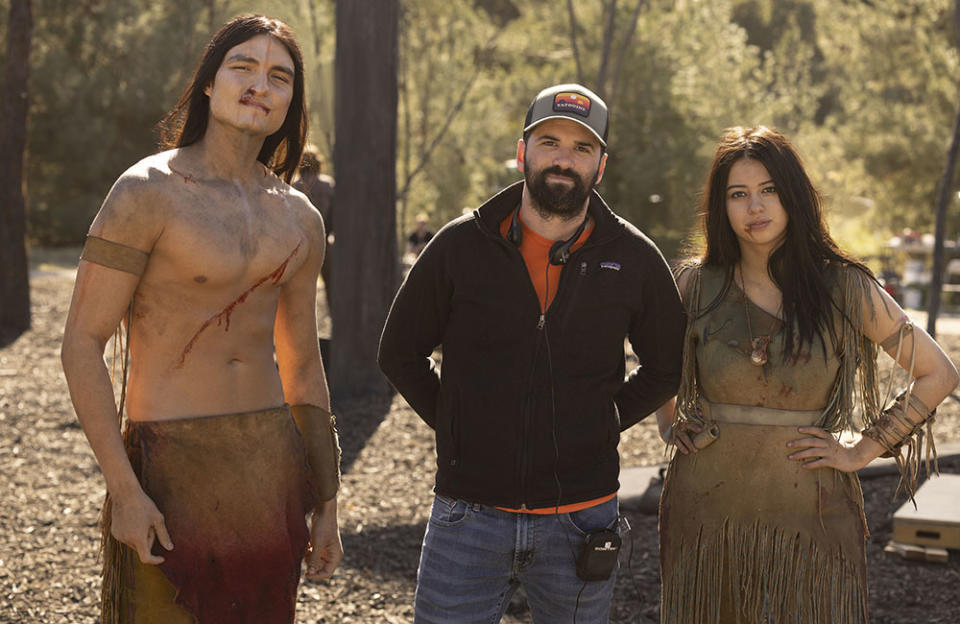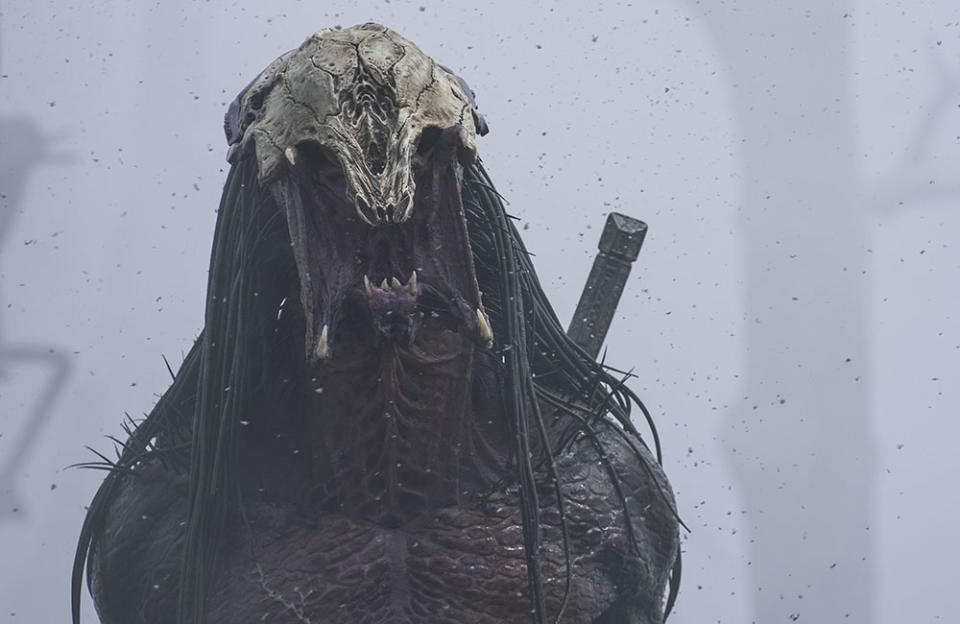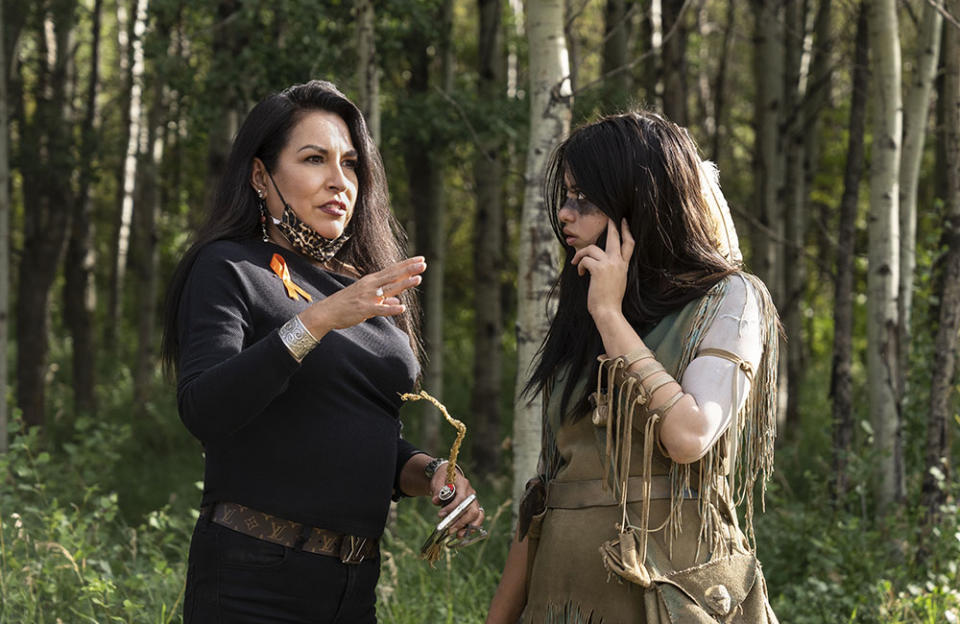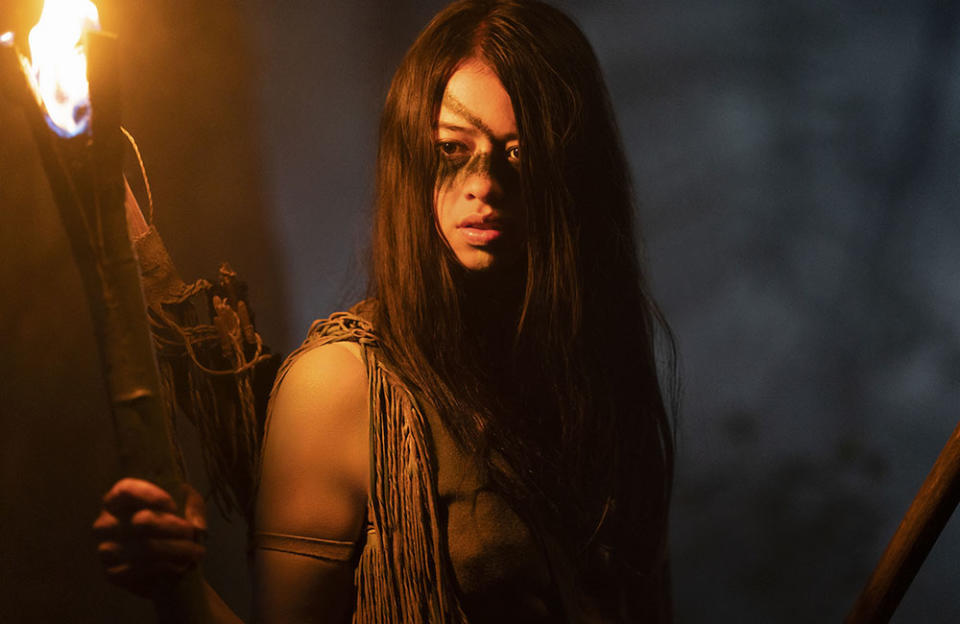How a Karate Tournament Carpool Inspired the New ‘Predator’ Movie, ‘Prey’
- Oops!Something went wrong.Please try again later.
- Oops!Something went wrong.Please try again later.
- Oops!Something went wrong.Please try again later.
- Oops!Something went wrong.Please try again later.

In 1987, Dan Trachtenberg was too young to see John McTiernan’s R-rated Predator, but the older kids in his karate tournament carpool insisted on telling him the whole movie anyway. And at the time, Trachtenberg distinctly remembers a story involving Sonny Landham’s half-Sioux tracker, Billy Sole, who died in a dramatic fight with the Predator. The only problem is that no such scene exists, something Trachtenberg would later figure out. Billy does decide to face the creature head on, but the scene cuts away, leaving the audience with only his blood-curdling scream to infer death.
Oddly enough, rumors have persisted for years that Billy Sole’s full death scene was included in rare VHS releases or TV edits, but there is no concrete evidence to support that such a scene is anything but a myth. Thankfully, a mere rumor led to something very real 35 years later.
More from The Hollywood Reporter
'Predator' Star Jesse Ventura Praises "Thoughtful" and "Creative" Prequel 'Prey'
Events of the Week: 'Bullet Train,' 'A League of Their Own' and More
“So the seed was planted, and then I thought, ‘Wouldn’t it be awesome to have a movie that focuses on [Billy Sole’s] story?’ And Prey isn’t exactly that, but it is, spiritually,” Trachtenberg tells The Hollywood Reporter.
Prey, which tells the story of a young Comanche warrior’s (Amber Midthunder’s Naru) encounter with a Predator (Dane DiLiegro) in 1719, also features a Comanche-language dub option via Hulu. Authenticity was extremely important to Trachtenberg and his producer Jhane Myers, who is an enrolled member of Comanche Nation.
“Everything is exact, correct and authentic, and sometimes, when films are made, it’s not always done that way. It’s either an afterthought or it’s done on the fly. So it means a lot to have [the Comanche dub] in there and to have it be correct,” Myers says.
In a recent conversation with THR, Trachtenberg and Myers also discuss the artistic closing credits, which allude to the next chapter in the story. Trachtenberg, who directed 2016’s 10 Cloverfield Lane, then explains how Star Wars influenced the Predator-less title.
Dan, I’ve been anxiously awaiting your second feature for what feels like 84 years now.
Dan Trachtenberg: (Laughs.) Yeah, me too.
While I’m sure there was plenty of frustration along the way, are you ultimately glad that it worked out this way?
Trachtenberg: I am. There were certainly things that I almost made along the way, but now, having made something that is exciting, visceral and thrilling, and hopefully emotional and moving, I know that this would not have been the case had I taken some other jobs. So I’m really glad that I held out and made something that I cared about.

Jhane, you’ve been a part of Indigenous stories in the past, but nothing quite like this. How did this come together for you?
Jhane Myers: Well, I was excited to do this, and it came together through Scott Aversano, who is the [executive vice president] of 20th Century. He met me, and then introduced me to Dan and I got to interview for the producer position. Of course, it was during the pandemic, so things shut down and all work stopped. So some things were sidelined, and I had also interviewed for some other jobs. But when I found out about this, I just knew I wanted it because I rarely get to produce something totally in my culture. I’m an enrolled member of the Comanche Nation.
When I first heard about Prey, I immediately wondered if Predator’s Billy Sole (Sonny Landham), who was half-Sioux, led to this idea. He always seemed to have a deeper, more instinctual understanding of the creature than the other characters, and apparently, he did inspire the idea, right?
Trachtenberg: That’s right, yeah. I was in third grade when Predator came out, and I was not allowed to see R-rated movies. So then I found myself in the back of a carpool on the way to a karate tournament with all the sixth graders who had just seen Predator, and they spent the entire ride telling me the entire movie. And I vividly remembered that they said there was a scene where Billy, the Native American tracker, stood on a bridge over a waterfall and fought the Predator. But when I eventually saw the movie, that scene was not in it. (Laughs.) The beginning of it is, but then it cuts away. So the seed was planted, and then I thought, “Wouldn’t it be awesome to have a movie that focuses on that character’s story?” And Prey isn’t exactly that, but it is, spiritually.
Yeah, all we got was Billy’s distant scream, which remains a disappointment. [Writer’s Note: Apparently, rumors of a proper Billy death scene have persisted for years despite no direct evidence.] Anyway, authenticity was clearly a priority to the two of you. Are there any particular details you were especially proud to include?
Myers: Everything. Everything from the score to the people that were in front of the camera, the people behind the camera, the war paint and the face paint that we all developed specifically for these characters, the hairstyles, the costuming. Our costume designer, Stephanie Porter, was like a little sponge. I actually set up a satellite office over there instead of being in the regular production office, so I could be hands-on in their area and just work with everything. So I love everything all the way to the end. Did you see the end credits?
I sure did!
Myers: We know this movie takes place 300 years ago, so it’s not rock art and we didn’t have paper yet to do the ledger art that you see today. So we did hide art. We had top award-winning Native American fine artists that helped create this, and they worked with Filmograph to create that end-credit sequence, which was amazing to work on.

Since you brought up the closing credits, I might as well inquire about them now. They suggest that there’s more to this story, so how far ahead are you in terms of figuring out the next chapter?
Trachtenberg: The nerd in me looked that far ahead, as far as he could look, before we started writing this movie, but the adult in me said, “Don’t count your chickens and just be careful. Try and make the best movie possible, straight away.” End-credit sequence aside, there is something refreshing about seeing a movie that is not really intended to be just a part one to something else. There’s something nice about seeing a complete thought. On the complete other hand, I love that what would’ve been a post-credit scene in other movies, is an animated end-title sequence in our movie. Our end titles are still storytelling.
It was definitely a nice touch and very tasteful. So how did you get away with not putting Predator in the title? There must have been some spirited debates about that.
Trachtenberg: (Laughs.) It’s the craziest thing. [Prey] was in my initial pitch for the movie. They were making the Shane Black movie [2018’s The Predator] that I assumed was intended to be a franchise starter, a trilogy perhaps, or what have you. So I knew the only way that they would agree to making this other kind of Predator movie is if I pitched it as what Rogue One or Solo are to the Star Wars franchise. So Prey would also be this other thing, and the title really suggests that it’s sort of a mirror to the main franchise. So that was in the initial pitch, and then I started pitching other titles. But everyone really fell in love with Prey, and I think it works so well because it has the exact same double meaning that Predator has. And there certainly is precedent. Other movies have used different titles that are still inside of another IP, and I think this one proves that you can still have success without calling something Part Two, Begins or what have you.
Even though it has some cool elements in it, it’s safe to say that the 2018 film didn’t connect with audiences. Did the performance of that film make a green light harder to come by in your case?
Trachtenberg: Well, first of all, I agree with you. There was a lot of awesome stuff in that movie. And frankly, that movie came out right around the same time that the Fox-Disney merger happened, so it’s hard to really say what put the brakes on this movie. But I’m just thrilled that the dust has settled and we got picked up again. The production of this movie was far better off than it was going to be in that earlier version, for sure.

Jhane, what can you tell me about the Comanche-language option?
Myers: There is an option for it, and I recommend watching it. This movie is so good that you can watch it [either way]. But it was really rewarding for me to be able to work on something like this, because my language is in an entire movie with the Predator. It’s incredible. Two of our top people in our tribe of language speakers stepped forward to help us on this. We had our number-one conversational speaker, Guy Narcomey, and then we also had Kathryn Briner, who is the director of the Comanche Nation Language Department. So everything is exact, correct and authentic, and sometimes, when films are made, it’s not always done that way. It’s either an afterthought or it’s done on the fly. Sometimes, it’s not even a [real] language; it’s romanticized. So it means a lot to have [the Comanche dub] in there and to have it be correct.
The juxtaposition of past and future weaponry was quite interesting. Did you enjoy that challenge of figuring out ways for the Comanche to truly hold their own?
Trachtenberg: Yeah, one of the reasons why the Comanche are the center of this movie is because they were the most fierce warriors to walk this continent, arguably, and they were incredibly innovative. Part of the idea of Naru [Amber Midthunder] creating the weapon that she creates, comes from trying to represent that spirit, and then having the Predator have an arsenal that is familiar and new at the same time allows for an exciting grudge match that makes it different from any other entries in the franchise.
Did you take artistic license with the orange totsiyaa, or is that a somewhat real healing property?
Myers: The Comanche have healing properties, and we do use medicinal flowers and other things that we can gather. But we just kind of enhanced some things. Totsiyaa really means flower. (Laughs.)
Trachtenberg: The interest there was not wanting to do mud again [like Predator], but still having the same result. It’s also something that Naru rejected at the beginning of the movie. It’s been instilled in her from her mother, but she’s turned away from it because she feels like she wants something else. But then she realizes at the end of the movie, “Oh, that thing that I was saying no to was actually the thing that I need to embrace.” And once again, it embraces the Comanche gift for being adaptable.

Amber Midthunder gives a revelatory performance, to say the least. Was there an exhaustive search to find Naru?
Trachtenberg: It certainly was intense. But as soon as I started talking to Amber, I hoped she was Naru because she’s delightful to be around. And when we auditioned her, she did the scene between her and her mother, which was very moving. And then we did a version of that scene, silent. Sometimes, even while making a movie, we’ll do a verbal scene, but performed without the words. And Amber’s take on that scene in that way was very, very powerful. And eventually, both her and Dakota [Beavers] performed a scene in Comanche, and after only one day of studying the language and Jhane helping them, they were already inherently great at it. And then there was a physical test as a little bit of an obstacle course was set up. We had a stunt coordinator there to investigate their physicality because I’m big on swashbuckle. The way a character moves can be as exciting as anything else in the movie, and Amber was just so gifted at not merely crawling, leaping and sliding, but also telling a story within those movements, which is so critical in a movie where story is told largely through action. So she was an incredible find, for sure.
***
Prey is now streaming on Hulu. This interview was edited for length and clarity.
Best of The Hollywood Reporter
